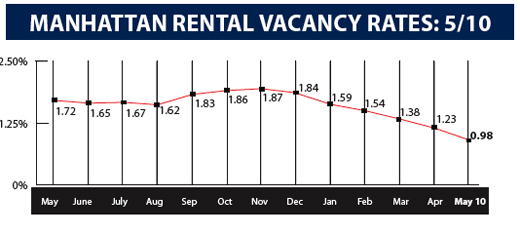Trending
May rental market sees modest improvement
The rental market has improved in all but a handful of Manhattan neighborhoods, according to a report released today by brokerage Citi Habitats.
The overall vacancy rate for Manhattan dropped to .98 percent, according to the report, from 1.23 in April and 1.72 in May 2009. At the same time, rents showed less fluctuation, borough-wide.
Vacancy rates in neighborhoods such as the West Village, Soho/Tribeca and Chelsea, were far lower than the borough-wide average, with vacancy rates at .33 percent, .52 percent and .62 percent, respectively.
But the Upper East Side, Midtown East and Midtown West still saw higher-than-average vacancy rates of 1.47 percent, 1.38 percent and 1.22 percent, respectively.
The monthly report, which is based on Citi Habitats rental transactions, showed a somewhat more moderate year-over-year change in average rents.
The average price for studios climbed to $1,813 last month from $1,765 the same month a year earlier. Three-bedroom units, meanwhile, declined to $4,496 last month from $4,657 in May 2009. One-bedroom and two-bedroom average monthly rents stayed relatively flat.
Gary Malin, president of Citi Habitats, said that the report reflects a market rebound.
Anticipating a strengthening in the market, Malin said renters will have more competition for prime units.
“Clients are going to have to be prepared to act quickly,” Malin said. “I think a lot of people aren’t going to be accustomed to that.”
Malin conceded that market seasonality may be influencing activity, but said that this year’s rental peak season — which typically spans from May into the summer months — is proving to be more active than in 2009.
“The rental market historically does have peak season months, no question about that,” Malin said. “But, if you go back a year ago… it’s not really as though the vacancy rate took a dip [as it is now].”
While the unemployment rate in New York City has worsened over the last year — climbing to 9.8 percent in April, according to State Department of Labor statistics, up from 8.9 percent during the same month a year earlier — Malin seemed relatively unconcerned.
According to Malin, renters are snagging apartments, regardless of their employment status.
“[There is an] influx of people — whether they have jobs or not,” Malin said. “They’re coming to the city and they’re hoping for the best.”





